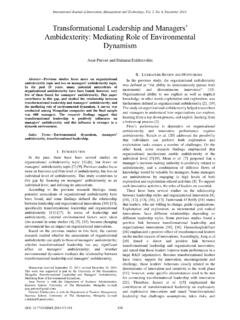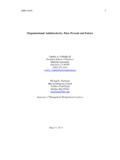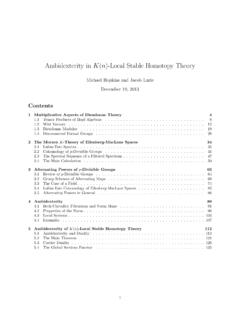Transcription of Organizational Ambidexterity in Small Firms: The Role of ...
1 Journal of Business & Economic Policy Vol. 2, No. 4; December 2015 31 Organizational Ambidexterity in Small Firms: The Role of Top Management Team Behavioral Integration and Entrepreneurial Orientation Huy Q. Tran Department of Business, Accounting and Economics Albright College 1621 N. 13thStreet, Reading, PA 19604 USA Abstract This study proposes a conceptual model that explains the relationship between top management team (TMT) behavioral integration in the interaction with the entrepreneurial nature of Small firms and the two dimensions of Organizational Ambidexterity (OA). Furthermore, it suggests that each of the two OA dimensions balance dimension and combined dimension has a different impact on firm performance. While the combined dimension of OA positively contributes to firm performance, the balance dimension of OA is more likely to have an inverted U-shaped relationship with firm performance.
2 The present research, therefore, sheds more light on the conceptualization of OA as well as the relationship between OA and its managerial antecedents and Organizational consequences. Keywords: exploration, exploitation, Organizational Ambidexterity , top management team behavioral integration, entrepreneurial orientation. 1. Introduction Research on exploration, exploitation, and Organizational Ambidexterity (OA) has burgeoned for the last two decades (Gupta, Smith, & Shalley, 2006; Lavie, Stettner, & Tushman, 2010; Levinthal & March, 1993; Raisch & Birkinshaw, 2008; Simsek, 2009; Simsek, Heavey, Veiga, & Souder, 2009). While companies try to improve their operational efficiency by exploiting and refining their current capabilities and processes, they must also develop new products/services and expand their market scope in order to create and sustain their competitive advantages.
3 Therefore, being ambidextrous balancing exploration with exploitation is crucial for a firm s survival and prosperity (March, 1991). Although the notion of (OA) is very tempting, the extant literature is fragmented and shows limitations which must be addressed if the literature is to move forward. First, the existence of a wide variety of conceptualizations and operationalizations of OA leads to weak and mixed empirical findings on the relationship between OA and its Organizational consequences. Second, the extant literature seems to focus too much on what OA looks like ( , the modes of OA) rather than what factors facilitating or impeding OA ( , antecedents of OA). In other words, more studies on antecedents of OA are expected to come. Third, while a great deal of research investigates OA in a context of large, publicly traded corporations, there have been few studies focusing on the phenomenon in the context of Small businesses.
4 Interestingly, researchers argue that Small organizations or divisions of a multi business corporation are suitable units for OA research (Gibson & Birkinshaw, 2004). Finally, the extant literature seems to overemphasize the trade-offs rather than the combination or synergy between exploration and exploitation. Researchers have called for the shift from either/or to both/and perspective (Gibson & Birkinshaw, 2004; Piao, 2010). The present study proposes that research on OA in Small businesses needs to investigate the role of top management team (TMT) in deciding whether or not the firm pursues or avoids OA. Conceptualizing OA as a multidimensional construct, the present paper further proposes that the entrepreneurial nature of the firm plays a significant role in predicting on which OA dimension should be focused. ISSN 2375-0766 (Print), 2375-0774 (Online) Center for Promoting Ideas, USA 32 The current study also examines the effect of OA on firm performance and, thus, sheds more light on the relationship between OA and Organizational outcomes.
5 2. Theory and Propositions Research on Exploration and Exploitation Definitions of Exploration and Exploitation Benner and Tushman (2003) classify innovations along two dimensions: (1) how radical the innovation is, compared with current technological trajectory; and (2) the newness of customer groups or markets that innovation is designed to serve. They suggest that exploitation involves incremental innovations that are close to the current knowledge base of the firm and innovations designed to meet the needs of current customers or markets. Exploration, however, refers to radical innovations or innovations aimed to meet the needs of emerging customers or markets. The present study adopts these definitions of exploration and exploitation which are consistent with Levinthal and March s (1993) perspective on Organizational learning: exploration is concerned with the pursuit of new knowledge, of things that might come to be known and exploitation refers to the use and development of things already known (Levinthal & March, 1993, p.)
6 105). The Relationship between Exploration and Exploitation March s (1991) framework implies that there are inherent trade-offs between exploration and exploitation due to the fact that they both compete for the organization s scarce resources. Besides competing for resources, each type of the activities requires a distinct Organizational design to maintain the consistency among internal operational processes (Ebben & Johnson, 2005). Furthermore, exploration and exploitation tend to engender different Organizational outcomes. According to March (1991), the effects of exploration are less certain, more remote in time, and more distant from the locus of action, compared to those of exploitation. March (1991), therefore, posits that although both types of activities are essential for Organizational prosperity, organizations have to make choices between the two.
7 In line with this perspective, some studies have found empirical evidence on the negative association between exploration and exploitation ( , Lavie, Kang, & Rosenkopf, 2009; Lavie & Rosenkopf, 2006; Lavie, Stettner, & Tushman, 2010; Lin, Yang, & Demirkan, 2007; Uotila, Maula, Keil, & Zahra, 2009). Lavie and his colleagues (2010) specifically posit that the distinction between exploration and exploitation is often a matter of degree rather than kind. Accordingly, exploration-exploitation should be viewed as a continuum rather than a choice between discrete options (p. 114). Other scholars, however, conceptualize exploration and exploitation as two interrelated, but separate, constructs ( , He & Wong, 2004; Menguc & Auh, 2008; Schulze, Heinemann, Abedin, 2008). Although these researchers acknowledge the tensions between exploration and exploitation, they contend that an organization can simultaneously achieve both types of activities at high levels.
8 Therefore, those scholars believe that the difference between exploration and exploitation is a matter of kind rather than degree. Indeed, such a continuity-versus-orthogonality issue is one of the central questions that need to be addressed in order for the exploration-exploitation literature to progress (Gupta, Smith, & Shalley, 2006). This issue becomes an essential base for research on a balance between exploration and exploitation, or Organizational Ambidexterity . Gupta and his colleagues (2006) contend that the relationship between exploration and exploitation depends largely on whether the two compete for scarce resources and whether they are investigated within a single or across domains. Consequently, they posit that it is important for researchers to justify their decision on the issue of continuity versus orthogonality on a theoretical and logical basis (Gupta et al.)
9 , 2006). What is Organizational Ambidexterity ? Organizational Ambidexterity (OA) was originally studied in situations in which a firm maintains dual structures simultaneously: one focuses on initiating and the other on executing innovations (Duncan, 1976).Such a firm is called an ambidextrous organization. Therefore, structural separation has been considered as a traditional means for a firm to achieve OA (Duncan, 1976; Tushman & O Reilly, 1996). Later, other modes of being ambidextrous, such as contextual Ambidexterity (Gibson & Birkinshaw, 2004) and domain separation (Lavie, Kang, & Rosenkopf, 2009), have been investigated. The most salient issue with all of the three approaches is that they focus on a static snapshot of OA, using cross-sectional data. When timing dimension is considered, another form of OA temporal separation is introduced. Journal of Business & Economic Policy Vol.
10 2, No. 4; December 2015 33 Drawing on the literature of punctuated equilibrium (Romanelli & Tushman, 1994), temporal separation suggests that in order to avoid the tensions between exploration and exploitation the firm should focus on either of the two at any point in time. Thus, over time the firm can be considered ambidextrous (Lavie et al., 2010). We, however, need to go further by asking the following questions: what does an exploitation-exploration balance really mean? Does this mean relatively equal amounts of exploitation and exploration in a continuum in which a trade-off between the two occurs ( , March, 1991; Lavie et al., 2010)? If this is the case, the balance between exploration and exploitation may locate somewhere in the middle of the continuum. From a different perspective, does the balance mean that the firm can attain high levels of both exploitative and exploratory activities at the same time ( , He & Wong, 2004)?










